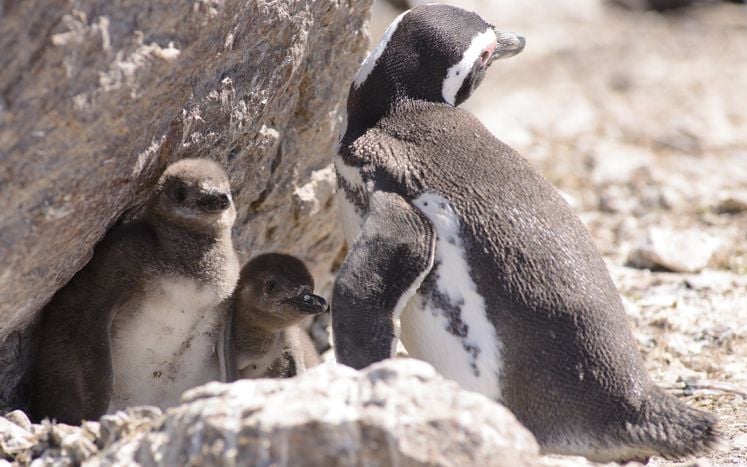Ever wondered how long it takes for a penguin egg to hatch or when you’re most likely to see penguin chicks in colonies around South America? We’ve got all the information you need with this article about the penguin life cycle of four South American penguin species, Magellanic, Humboldt, Galapagos and king.
Magellanic penguin life cycle
Magellanic penguins are the most prevalent penguin species found in South America, with some of the largest colonies in the continent found at Isla Magdalena in the Magellanic Straits of Chile (estimated population: 120,000) and Punta Tombo in Argentina (estimated population: 400,000).

The life cycle of Magellanic penguins is as follows:
- September: Magellanic penguins return to their nests.
- October: Two eggs are laid.
- November: Eggs are incubated for 40 days, with the females initially looking after them while the males hunt for food.
- December/January: When hatched, the parents take one-month turns to look after their offspring. During this time, the other parent is in the sea searching for food.
- February: The baby penguins remain in their nests until they have grown their adult feathers.
- March: Molting season begins and lasts for a month. All of the penguins, including the chicks, then return to the sea.
Humboldt penguin life cycle
Around 32,000 Humboldt penguins are estimated to exist on the planet, living along the Pacific coasts of Peru and Chile. Humboldt penguins can raise two clutches of eggs annually and as such are seen at their breeding colonies throughout the year.
Their life cycle is as follows:
- Breeding normally takes places between April and July and August and December.
- Two eggs are laid, four days apart. They are incubated for up to 42 days by both parents.
- Chicks develop their plumage and after 10-12 weeks leave to hunt at sea.
- Once the chicks have left the nest, the adults molt and then forage at sea to build up their strength before beginning the mating process again.
Galapagos penguin life cycle
The penguin species with the northernmost habitat, Galapagos penguins are only found on the Galapagos archipelago. The WWF estimates the population of Galapagos penguins to stand at fewer than 2,000 individuals.
 Galapagos penguins have adapted to their habitat by laying eggs up to three times a year to take advantage of periods of high food availability. They do not have a specific window of time for breeding and are resident in their colonies throughout the year.
Galapagos penguins have adapted to their habitat by laying eggs up to three times a year to take advantage of periods of high food availability. They do not have a specific window of time for breeding and are resident in their colonies throughout the year.
The Galapagos penguin follows this cycle:
- In preparation for breeding, Galapagos penguins molt and must avoid entering the water as their feathers make them waterproof. As molting leaves them unable to hunt, before beginning the process, they will increase their daily food intake by up to three times.
- When the water temperature drops, Galapagos penguins begin breeding, as this indicates that the seas are now rich in prey and it is an ideal time to raise young. They build a nest and lay two eggs, four days apart.
- The eggs are incubated for up to 40 days, with each parent taking their turn.
- After hatching, chicks need 30 days to grow their initial plumage and are brought food by their parents for an additional 65 days.
- For around a year, they remain in the company of one of their parents while the other goes out to hunt for food.
King penguin life cycle
King penguins in South America are confined to Bahía Inútil in Chilean Patagonia, where over one hundred birds have formed a colony.
King penguins have a specific breeding cycle:
- November/December: The female lays one egg which is incubatedon her and the male’s feet for a period of 55 days.
- January: The chicks hatch and remain on their parents’ feet for a further 30-40 days, by which point they will have grown feathers and are able to regulate their own body temperature.
- February/March: Chicks are left in a “crèche” while their parents go off to forage for food.
- It takes up to thirteen months for a chick to develop its waterproof feathers, leaving it reliant upon its parents up until this point.
No comments yet
There are no comments on this post yet.






Leave a comment